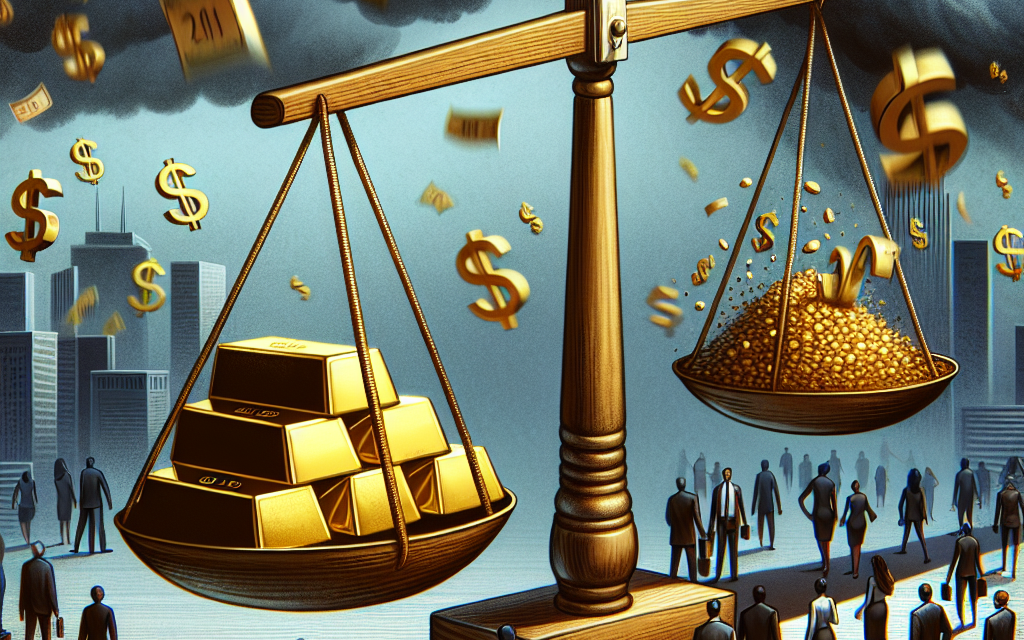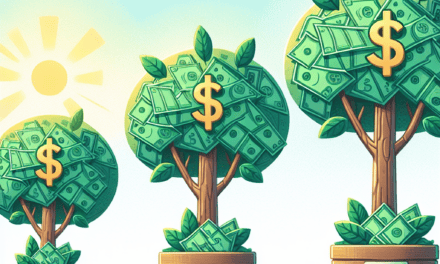“Gold Shines Bright: A Safe Haven as Investors Navigate US Rate Uncertainty.”
Introduction
Gold has maintained a steady position in the market as investors seek refuge from the volatility caused by uncertainty surrounding U.S. interest rates. Amid fluctuating economic indicators and potential shifts in monetary policy, gold’s status as a safe-haven asset has become increasingly appealing. As concerns about inflation and geopolitical tensions persist, market participants are turning to gold to preserve wealth and hedge against potential downturns, reinforcing its role as a reliable store of value in uncertain times.
Gold’s Role as a Safe Haven Asset
In times of economic uncertainty, investors often seek refuge in safe haven assets, and gold has consistently emerged as a preferred choice. This precious metal has long been regarded as a store of value, particularly during periods of market volatility and geopolitical tensions. As the global economy grapples with fluctuating interest rates and inflationary pressures, the allure of gold becomes even more pronounced. Investors are increasingly turning to gold not only as a hedge against inflation but also as a safeguard against potential losses in more volatile asset classes.
The intrinsic value of gold lies in its historical significance and its limited supply. Unlike fiat currencies, which can be printed at will by central banks, gold is a finite resource, making it less susceptible to devaluation. This characteristic is particularly appealing in an environment where monetary policy is uncertain, as is the case with the current landscape of U.S. interest rates. As the Federal Reserve navigates the complexities of inflation and economic growth, the potential for rate hikes or cuts creates a climate of unpredictability. In such scenarios, gold often shines as a beacon of stability.
Moreover, gold’s performance tends to be inversely correlated with the strength of the U.S. dollar. When the dollar weakens, gold prices typically rise, as it becomes cheaper for foreign investors to purchase the metal. Conversely, a strong dollar can exert downward pressure on gold prices. However, in the current context of fluctuating interest rates, the dollar’s trajectory remains uncertain, prompting many investors to diversify their portfolios by allocating a portion of their assets to gold. This diversification strategy not only mitigates risk but also positions investors to benefit from potential price appreciation in gold.
Additionally, gold’s role as a hedge against inflation cannot be overstated. As central banks around the world implement expansive monetary policies to stimulate growth, concerns about rising inflation have become increasingly prevalent. Gold has historically maintained its purchasing power over time, making it an attractive option for those looking to preserve wealth. In an environment where consumer prices are on the rise, the demand for gold as a protective asset is likely to increase, further solidifying its status as a safe haven.
Furthermore, the geopolitical landscape plays a significant role in shaping investor sentiment towards gold. Heightened tensions, whether due to trade disputes, military conflicts, or political instability, often lead to increased demand for gold. Investors tend to flock to gold during such times, viewing it as a reliable asset that can withstand external shocks. This behavior reinforces gold’s reputation as a safe haven, as it provides a sense of security amid uncertainty.
In conclusion, gold’s enduring appeal as a safe haven asset is underscored by its historical significance, limited supply, and ability to hedge against inflation and geopolitical risks. As investors navigate the complexities of the current economic landscape, characterized by U.S. rate uncertainty, the demand for gold is likely to remain robust. By incorporating gold into their investment strategies, individuals can not only safeguard their wealth but also position themselves to capitalize on potential market fluctuations. Ultimately, gold continues to serve as a cornerstone of financial security, offering a reliable refuge in an ever-changing world.
Impact of US Rate Uncertainty on Gold Prices
In recent months, the financial landscape has been characterized by a notable degree of uncertainty surrounding U.S. interest rates, which has had a significant impact on various asset classes, particularly gold. As investors grapple with the implications of potential rate changes, gold has emerged as a safe haven, maintaining its value amidst the volatility. This phenomenon can be attributed to several interconnected factors that influence both investor sentiment and market dynamics.
To begin with, the Federal Reserve’s monetary policy decisions play a crucial role in shaping the economic environment. When the Fed signals a potential increase in interest rates, it often leads to a stronger U.S. dollar, which can exert downward pressure on gold prices. Conversely, when uncertainty prevails regarding the timing and magnitude of rate hikes, gold tends to benefit as investors seek refuge from the unpredictability of the equity markets. This flight to safety is particularly pronounced during periods of economic instability or geopolitical tensions, where gold’s intrinsic value as a tangible asset becomes increasingly appealing.
Moreover, the current inflationary pressures in the U.S. economy further complicate the interest rate outlook. As inflation rates rise, the real yield on bonds tends to decline, making gold a more attractive investment. Investors often turn to gold as a hedge against inflation, which can erode the purchasing power of fiat currencies. In this context, the steady performance of gold can be seen as a reflection of its enduring appeal as a store of value, especially when traditional fixed-income investments offer diminishing returns.
Additionally, the global economic landscape is marked by a myriad of challenges, including supply chain disruptions and geopolitical tensions. These factors contribute to a heightened sense of uncertainty, prompting investors to reassess their portfolios. In such an environment, gold’s historical role as a safe haven asset becomes increasingly relevant. As market participants seek to mitigate risk, the demand for gold tends to rise, thereby supporting its price stability.
Furthermore, the behavior of institutional investors also plays a pivotal role in shaping gold prices. Many large investment firms and hedge funds have increased their allocations to gold in response to the prevailing economic conditions. This trend is indicative of a broader shift towards risk management strategies that prioritize capital preservation. As institutional demand for gold rises, it reinforces the metal’s status as a reliable asset during turbulent times, further contributing to its price stability.
In conclusion, the interplay between U.S. rate uncertainty and gold prices is a complex and multifaceted relationship. As investors navigate the challenges posed by fluctuating interest rates, inflationary pressures, and global economic uncertainties, gold remains a steadfast option for those seeking safety and stability. The metal’s ability to retain value in the face of adversity underscores its enduring appeal as a hedge against economic volatility. Consequently, as the market continues to react to evolving economic indicators and policy decisions, gold is likely to maintain its position as a critical asset for investors looking to safeguard their wealth in uncertain times.
Historical Trends: Gold Performance During Economic Instability
Throughout history, gold has consistently served as a safe haven for investors during periods of economic instability. This enduring appeal can be traced back to its intrinsic value, scarcity, and universal acceptance as a form of wealth. As economic uncertainties arise, particularly in the context of fluctuating interest rates and geopolitical tensions, investors often gravitate towards gold, seeking to preserve their capital and hedge against potential losses in other asset classes. The historical performance of gold during such tumultuous times underscores its role as a reliable store of value.
In the wake of the 2008 financial crisis, for instance, gold prices surged dramatically as investors fled from equities and other riskier assets. The crisis, characterized by a collapse in housing prices and a subsequent banking meltdown, led to widespread panic and uncertainty. During this period, gold not only maintained its value but also appreciated significantly, reaching an all-time high of over $1,900 per ounce in 2011. This trend illustrated how gold can act as a buffer against the volatility of financial markets, providing a sense of security for those looking to safeguard their investments.
Moreover, the historical context of gold’s performance during inflationary periods further highlights its significance. In the 1970s, the United States experienced stagflation, a combination of stagnant economic growth and high inflation. During this time, gold prices soared as investors sought refuge from the eroding purchasing power of fiat currencies. The metal’s ability to retain value in the face of rising prices reinforced its status as a hedge against inflation, a characteristic that continues to resonate with investors today.
Transitioning to more recent events, the COVID-19 pandemic triggered unprecedented economic disruptions worldwide. Governments implemented lockdowns, leading to a sharp contraction in economic activity and a surge in unemployment rates. In response to this crisis, central banks around the globe adopted aggressive monetary policies, including lowering interest rates and implementing quantitative easing measures. These actions, while aimed at stabilizing economies, raised concerns about potential long-term inflation and currency devaluation. Consequently, gold once again emerged as a favored asset, with prices reaching new heights as investors sought to mitigate risks associated with economic uncertainty.
In addition to its historical performance during financial crises, gold’s appeal is further bolstered by its unique characteristics as a tangible asset. Unlike stocks or bonds, gold is not subject to the same market dynamics and can provide a sense of security that is often lacking in more volatile investments. This intrinsic value, coupled with its limited supply, creates a compelling case for gold as a long-term investment strategy, particularly in times of economic distress.
As we navigate the current landscape of economic uncertainty, characterized by fluctuating interest rates and geopolitical tensions, the historical trends surrounding gold’s performance offer valuable insights. Investors are increasingly recognizing the importance of diversifying their portfolios and incorporating gold as a means of safeguarding their wealth. The metal’s resilience during past economic downturns serves as a reminder of its enduring role in the financial ecosystem. Ultimately, as uncertainty looms, gold remains a steadfast choice for those seeking stability and security in an ever-changing economic environment.
Investor Sentiment: Why Gold is Gaining Popularity
In recent months, gold has emerged as a favored asset among investors, reflecting a growing sentiment towards safety amid the prevailing uncertainty surrounding U.S. interest rates. As central banks navigate the complexities of inflation and economic growth, the allure of gold as a hedge against volatility has become increasingly pronounced. This trend is not merely a reaction to immediate market fluctuations; rather, it signifies a broader shift in investor psychology, where the quest for stability takes precedence over the pursuit of higher returns.
The backdrop of fluctuating interest rates plays a pivotal role in shaping investor sentiment. As the Federal Reserve contemplates its monetary policy, the potential for rate hikes or cuts creates an environment of unpredictability. In such scenarios, gold often shines as a reliable store of value. Unlike interest-bearing assets, gold does not yield dividends or interest, yet its intrinsic value tends to hold firm, particularly during periods of economic uncertainty. Consequently, investors are drawn to gold as a safeguard against potential losses in other asset classes, such as equities or bonds, which may be adversely affected by rising rates.
Moreover, the geopolitical landscape further amplifies the appeal of gold. With tensions simmering in various regions and the specter of economic sanctions looming, investors are increasingly wary of the potential for market disruptions. In this context, gold serves as a safe haven, providing a sense of security that is often absent in more volatile investments. The historical performance of gold during crises reinforces this perception, as it has consistently demonstrated resilience in the face of adversity. As a result, many investors are reallocating their portfolios to include a greater proportion of gold, seeking to mitigate risk and enhance their overall financial stability.
In addition to these factors, the ongoing concerns regarding inflation have also contributed to gold’s rising popularity. As prices for goods and services continue to climb, the purchasing power of fiat currencies diminishes, prompting investors to seek alternatives that can preserve their wealth. Gold, with its long-standing reputation as a hedge against inflation, becomes an attractive option in this scenario. The metal’s finite supply and inherent value make it a compelling choice for those looking to protect their assets from the erosive effects of rising prices.
Furthermore, the accessibility of gold investment options has expanded significantly in recent years, making it easier for a broader range of investors to participate in the market. From physical bullion to exchange-traded funds (ETFs) and digital gold platforms, the variety of ways to invest in gold has democratized access to this traditional asset. This increased accessibility has not only attracted seasoned investors but has also piqued the interest of younger generations who are more inclined to explore alternative investment avenues.
As we look ahead, it is clear that gold’s status as a safe-haven asset is likely to endure, particularly in an environment characterized by economic uncertainty and fluctuating interest rates. The interplay of these factors continues to shape investor sentiment, driving demand for gold as a means of preserving wealth and mitigating risk. In conclusion, as investors navigate the complexities of the current financial landscape, gold remains a steadfast choice, embodying the timeless quest for security and stability in an ever-changing world.
Diversifying Portfolios with Gold Amid Market Volatility
In an era marked by economic unpredictability and fluctuating market conditions, investors are increasingly seeking refuge in gold as a means of diversifying their portfolios. The allure of gold as a safe-haven asset has been particularly pronounced in recent months, as uncertainty surrounding U.S. interest rates continues to loom large. As central banks navigate the complexities of inflation and economic growth, the stability that gold offers becomes even more appealing to those looking to mitigate risk.
Gold has long been recognized for its intrinsic value and historical significance as a store of wealth. Unlike fiat currencies, which can be subject to inflationary pressures and government policies, gold retains its purchasing power over time. This characteristic makes it an attractive option for investors who are wary of potential currency devaluation or economic downturns. As the Federal Reserve contemplates its next moves regarding interest rates, the potential for increased volatility in the stock market prompts many to consider gold as a stabilizing force within their investment strategies.
Moreover, the diversification benefits of including gold in a portfolio cannot be overstated. By allocating a portion of their investments to gold, individuals can reduce overall portfolio risk. This is particularly relevant during periods of market turbulence, where traditional asset classes such as stocks and bonds may experience significant fluctuations. Gold often exhibits a negative correlation with equities, meaning that when stock prices decline, gold prices may rise or remain stable. This inverse relationship can provide a buffer against losses, allowing investors to weather economic storms with greater resilience.
In addition to its role as a hedge against market volatility, gold also serves as a strategic asset during times of geopolitical uncertainty. As tensions rise on the global stage, investors often flock to gold as a means of preserving capital. The recent geopolitical events have underscored the importance of having a diversified portfolio that includes assets capable of withstanding external shocks. Gold’s historical performance during crises reinforces its status as a reliable asset, making it a prudent choice for those looking to safeguard their investments.
Furthermore, the accessibility of gold in various forms—such as physical bullion, exchange-traded funds (ETFs), and mining stocks—provides investors with multiple avenues to incorporate this precious metal into their portfolios. Each option comes with its own set of advantages and considerations, allowing investors to tailor their exposure to gold based on their individual risk tolerance and investment goals. For instance, physical gold offers the benefit of tangible ownership, while gold ETFs provide liquidity and ease of trading.
As the economic landscape continues to evolve, the importance of maintaining a well-diversified portfolio cannot be overstated. Gold’s unique properties as a safe-haven asset make it an essential component for investors seeking to navigate the complexities of the current market environment. By incorporating gold into their investment strategies, individuals can enhance their portfolio’s resilience against unforeseen challenges, ultimately positioning themselves for long-term financial stability.
In conclusion, as uncertainty surrounding U.S. interest rates persists, the steady appeal of gold remains a cornerstone for investors looking to diversify their portfolios amid market volatility. The combination of gold’s historical significance, its role as a hedge against risk, and its accessibility in various forms makes it an invaluable asset in today’s investment landscape. As such, investors would do well to consider gold as a strategic addition to their portfolios, ensuring they are well-prepared for whatever economic challenges may lie ahead.
The Relationship Between Interest Rates and Gold Investment
The relationship between interest rates and gold investment is a critical aspect of financial markets, particularly in times of economic uncertainty. As investors navigate the complexities of the global economy, fluctuations in interest rates often influence their decisions regarding asset allocation. Gold, traditionally viewed as a safe-haven asset, tends to attract attention during periods of heightened volatility, especially when the outlook for interest rates becomes ambiguous. This dynamic is particularly relevant in the current climate, where uncertainty surrounding U.S. monetary policy has prompted many investors to reassess their portfolios.
When interest rates rise, the opportunity cost of holding non-yielding assets like gold increases. Investors typically prefer assets that generate income, such as bonds or stocks, which can lead to a decrease in demand for gold. Conversely, when interest rates are low or expected to remain stable, the allure of gold often strengthens. In such environments, the lack of yield on gold becomes less of a deterrent, as the potential for capital appreciation and the asset’s role as a hedge against inflation become more pronounced. This inverse relationship underscores the importance of interest rate expectations in shaping gold prices.
Moreover, the Federal Reserve’s monetary policy decisions play a pivotal role in influencing interest rates and, by extension, gold investment. When the Fed signals a tightening of monetary policy, typically through interest rate hikes, it can lead to a stronger U.S. dollar. A stronger dollar often results in lower gold prices, as gold becomes more expensive for foreign investors. Conversely, when the Fed adopts a more accommodative stance, perhaps in response to economic slowdowns or financial crises, the dollar may weaken, enhancing gold’s appeal as a store of value. This interplay between the dollar and gold prices is a crucial consideration for investors seeking to navigate the complexities of the market.
In addition to interest rates, inflation expectations also significantly impact gold investment. When inflation rises, the purchasing power of currency diminishes, prompting investors to seek refuge in assets that can preserve value. Gold has historically been viewed as a hedge against inflation, and during periods of rising prices, demand for gold often increases. This relationship is particularly relevant in the current economic landscape, where concerns about inflation persist amid supply chain disruptions and geopolitical tensions. As investors grapple with these uncertainties, gold’s status as a reliable store of value becomes increasingly attractive.
Furthermore, geopolitical factors can exacerbate the relationship between interest rates and gold investment. In times of political instability or economic turmoil, investors often flock to gold as a safe haven, regardless of prevailing interest rates. This phenomenon highlights the multifaceted nature of gold as an investment, where psychological factors and market sentiment can sometimes overshadow traditional economic indicators. As a result, even in an environment of rising interest rates, gold may maintain its appeal if investors perceive heightened risks in other asset classes.
In conclusion, the relationship between interest rates and gold investment is complex and influenced by a myriad of factors, including monetary policy, inflation expectations, and geopolitical dynamics. As uncertainty surrounding U.S. interest rates continues to loom, investors are likely to remain vigilant, seeking safety in gold as a hedge against potential market volatility. This ongoing interplay between interest rates and gold underscores the importance of understanding market dynamics and the broader economic landscape when making investment decisions.
Future Outlook: Gold’s Stability in Uncertain Economic Times
As the global economy navigates through a landscape marked by uncertainty, particularly regarding interest rates in the United States, gold has emerged as a bastion of stability for investors seeking refuge from market volatility. The precious metal, often regarded as a safe-haven asset, has maintained its value amidst fluctuating economic indicators and geopolitical tensions. This resilience can be attributed to several factors, including inflationary pressures, currency fluctuations, and the ongoing shifts in monetary policy.
In recent months, the Federal Reserve’s stance on interest rates has been a focal point for investors. With inflation rates remaining stubbornly high, the central bank has grappled with the challenge of balancing economic growth while curbing price increases. As a result, speculation surrounding future rate hikes has created an atmosphere of uncertainty. In this context, gold’s appeal as a hedge against inflation becomes increasingly pronounced. Historically, gold has served as a reliable store of value during periods of rising prices, and this trend appears to be continuing as investors seek to protect their wealth.
Moreover, the geopolitical landscape has further solidified gold’s status as a safe haven. Ongoing conflicts, trade tensions, and political instability in various regions have prompted investors to turn to gold as a means of safeguarding their assets. The metal’s intrinsic value, coupled with its universal acceptance, makes it an attractive option during times of crisis. As uncertainty looms, the demand for gold tends to rise, reinforcing its stability in the market.
Additionally, the dynamics of the U.S. dollar play a crucial role in gold’s performance. As the dollar fluctuates in response to economic data and Federal Reserve policies, gold often moves inversely to the currency. A weaker dollar typically enhances gold’s appeal, as it becomes more affordable for foreign investors. Conversely, a stronger dollar can exert downward pressure on gold prices. However, in the current climate of rate uncertainty, the dollar’s trajectory remains unpredictable, which may further bolster gold’s position as a stable investment.
Looking ahead, analysts suggest that gold is likely to maintain its steadiness as long as economic uncertainties persist. The interplay between interest rates, inflation, and geopolitical factors will continue to shape investor sentiment. As central banks around the world, including the Federal Reserve, navigate their monetary policies, the implications for gold will be significant. Should inflation remain elevated or geopolitical tensions escalate, gold may see increased demand, reinforcing its role as a safe haven.
Furthermore, the growing interest in sustainable and ethical investing may also influence gold’s future outlook. As investors become more conscious of the environmental and social impacts of their investments, the gold industry is adapting to meet these demands. Initiatives aimed at responsible mining practices and transparency in the supply chain are gaining traction, potentially enhancing gold’s appeal among socially responsible investors.
In conclusion, as uncertainty looms over the economic horizon, gold’s stability is likely to endure. Its historical role as a safe haven, coupled with the current economic climate characterized by inflationary pressures and geopolitical tensions, positions gold as a prudent choice for investors seeking security. As the landscape continues to evolve, gold remains a steadfast option, reflecting its enduring value in uncertain times.
Q&A
1. **Question:** Why is gold considered a safe-haven asset during times of uncertainty?
**Answer:** Gold is viewed as a safe-haven asset because it tends to retain value and is less volatile compared to other investments during economic uncertainty.
2. **Question:** What recent economic factors have contributed to investors turning to gold?
**Answer:** Uncertainty surrounding US interest rates, inflation concerns, and geopolitical tensions have led investors to seek the stability of gold.
3. **Question:** How do US interest rates affect gold prices?
**Answer:** Higher interest rates typically strengthen the US dollar and can lead to lower gold prices, while lower rates often boost gold’s appeal as a non-yielding asset.
4. **Question:** What has been the trend in gold prices amid the current economic climate?
**Answer:** Gold prices have remained steady or slightly increased as investors seek safety amidst fluctuating economic indicators and rate uncertainties.
5. **Question:** Are there any specific events that have influenced gold’s stability recently?
**Answer:** Recent Federal Reserve meetings and economic data releases regarding inflation and employment have influenced investor sentiment towards gold.
6. **Question:** How do geopolitical tensions impact gold investment?
**Answer:** Geopolitical tensions often lead to increased demand for gold as a hedge against potential market instability and currency fluctuations.
7. **Question:** What is the outlook for gold in the context of ongoing US rate uncertainty?
**Answer:** The outlook for gold remains cautiously optimistic, as continued uncertainty around US rates may sustain demand for gold as a protective asset.
Conclusion
Gold remains a stable investment as investors seek safety in the face of uncertainty surrounding U.S. interest rates. The metal’s appeal as a hedge against inflation and economic instability continues to attract buyers, reinforcing its status as a safe haven asset. As market volatility persists, gold’s steady performance reflects a cautious approach by investors prioritizing security over risk.





